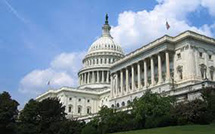 May 2017
May 2017
On May 1, Congress announced a bipartisan deal to fund the federal government through September 30, the remainder of fiscal year (FY) 2017. The omnibus bill includes 11 individual appropriations bills and was signed by the President on May 5.
The omnibus was a mixed bag for education researchers. The Institute of Education Sciences (IES) within the Department of Education was trimmed by 2 percent of the budget while the National Science Foundation (NSF) remained essentially flat at $880 million and the Eunice Kennedy Shriver National Institute of Child Health and Human Development (NICHD) received a 3 percent increase.
“While we are disappointed by the cuts to IES,” noted Executive Director Felice Levine, “the FY 2017 omnibus budget was in direct contrast to some of the dramatic cuts proposed in the administration’s ‘skinny budget’ and signaled, we anticipate, that Congress is unlikely to fall in line with the President’s vision for future federal budgets.”
Even before the FY 2017 appropriations process ended, appropriations committees in Congress, AERA, and the scientific community had begun the groundwork for FY 2018. AERA joined 800 organizations on a letter to House and Senate Appropriations Committee leadership calling for an increase to the allocation provided to the respective Labor, Health and Human Services, and Education and Related Agencies subcommittees. In recent years the subcommittee budget has been too low to adequately fund the range of important agencies under their jurisdiction—including the Department of Education and the National Institutes of Health.
AERA also submitted testimony to the House Labor, Health and Human Services, and Education and Related Agencies (LHHS) subcommittee on IES and to the House Commerce, Justice, Science, and Related Agencies (CJS) Subcommittee on NSF. In addition, AERA signed on to several coalition letters in support of funding for agencies supporting education research in FY 2018:
On May 23, President Trump released the administration’s budget request for FY 2018. The request proposes steep cuts to non-defense discretionary spending, such as slashing the budget of NSF by 11 percent to $6.65 billion. The proposed budgets for agencies supporting education research include:
- Institute of Education Sciences of the Department of Education—The administration requested $617 million in FY 2018, essentially flat with the FY 2016 appropriated level and slightly higher than what IES received in the final FY 2017 omnibus budget where IES was cut by nearly $13 million.
- Directorate for Education and Human Resources at the National Science Foundation—The administration requested $761 million for EHR in FY 2018, a decrease of $ 124 million over the FY 2016 appropriation of $884 million. The overall NSF budget of $6.65 billion would be the agency’s lowest funding level in a decade.
- National Institute of Child Health and Human Development—The administration requested $1.032 billion for FY 2018, a cut of $305 million from the final FY 2017 omnibus budget of $1.337 billion.
Despite the messaging and the proposed cuts in the president’s budget request, members of Congress from both parties have expressed that Congress has the authority to make decisions on spending. The scientific community has also criticized the Trump budget and potential impact on the federal research infrastructure. Rush Holt, the president of the American Association for the Advancement of Science, said in a statement, “Slashing funding of critically important federal agencies threatens our nation’s ability to advance cures for disease, develop new energy technologies, improve public health, train the next generation of scientists and engineers and grow the American economy.”